
Medical monitoring has advanced significantly in recent years, with one of the most exciting developments being the use of PPG (photoplethysmogram) technology. In this blog, we will define PPG technology, explain how it works, and discuss its potential to revolutionize medical monitoring.
PPG technology is a non-invasive method of monitoring vital signs such as heart rate and blood oxygen levels in humans. It measures blood flow in blood vessels using light and provides real-time data on a person’s vital signs. PPG technology works on the principle that blood absorbs and scatters light differently than other tissues in the body, and by measuring these differences, it can accurately monitor vital signs.
One of the most significant advantages of PPG technology is its lack of invasiveness. PPG technology, unlike traditional medical monitoring methods like electrocardiograms (ECGs) and pulse oximeters, does not require any skin-penetrating sensors or wires. This makes it a much more convenient and comfortable option for patients, as well as eliminating the infection risk associated with traditional monitoring methods.
Another advantage of PPG technology is its ability to monitor in real time. Healthcare providers can use PPG technology to monitor a patient’s vital signs in real time, eliminating the need for in-person visits. This allows for the early detection of changes in a patient’s health status, which can lead to earlier intervention and better patient outcomes.
PPG technology is also extremely adaptable, and it can be integrated into a wide range of devices, including smartphones, wearables, and remote monitoring devices. As a result, it is a versatile option for medical monitoring, allowing patients to receive care from the comfort of their own homes.
PPG technology has the potential to revolutionize medical research in addition to its benefits for patients. PPG technology can help researchers better understand the underlying causes of certain medical conditions and improve the development of new treatments by providing real-time data on a person’s vital signs.
PPG technology is also a low-cost medical monitoring option. Allowing healthcare providers to remotely monitor patients can reduce the need for in-person visits and hospital stays, resulting in lower healthcare costs for both patients and providers.
To summarize, PPG technology is a medical monitoring revolution with the potential to significantly improve patient outcomes and reduce healthcare costs. PPG technology is a game changer in the world of medical monitoring due to its non-invasive nature, real-time monitoring capabilities, and versatility. We can expect even more growth in this field in the coming years as technology advances.
Table of Contents
ToggleAbout Us
Our cloud based, lightweight API allows Veyetals to be integrated with the healthcare apps and platforms that matter to you most. The app is interoperable with other healthcare management systems including, but not limited to, SenSights.AI. veyetals drives information sharing with other health management solutions and further enhances the continuum of patient care.
Download our FREE app here
Follow us on LinkedIn at veyetals.com for more updates



